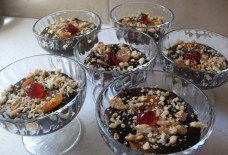Picturesque Carmona Offers Its Charm and History
By: Habeeb Salloum/Arab America Contributing Writer
Few urban centers in Spain have a more venerable history than Carmona – a town located some 36 km (22.5 mi) east of Seville. Its impressive medieval fortifications and its location on a promontory of the Sierra de Los Alcores hills, overlooking the fertile plains of the Guadalquivir valley, has placed this small city of over 28,000 on the itinerary of many tourist tours. A picturesque town with friendly inhabitants, it fits neatly into the surrounding rich farmlands, irrigated by the Carbones and Guadaira Rivers.
Archeological remains dating back to prehistoric times – to the Paleolithic and Neolithic periods have been found around the city. Carmona itself has been inhabited for at least 5,000 years. At first, it was a Turdetanian settlement, then later an important Carthaginian colony. In 206 B.C., it became a strategic Roman town and in the ensuing years grew to be the most powerful town in the Roman province of Hispania Ulterior.
From 712 A.D. and for five centuries thereafter, Carmona, under the name, Qarmuna, flourished under Arab rule. After the breakup of Muslim Spain, it became the capital of one of the many petty states that were created as a result of political upheavals. In 1247, the city was captured by Ferdinand III of Castile. Later, it gained fame during the Peninsular Wars when its horsemen helped drive back Napoleon’s elite, hereto unbeaten, Imperial Dragoons.
Today, Carmona is saturated with remains from this eventful historic past. The fortress, Alcázar de la Puerta de Seville, called the lower Alcázar, is noted for its Gate of Seville – a monumental fortress gate for those approaching from the city from Seville and leading to the historic part of the old city. The whole structure is an impressive defense complex with cisterns, galleries, halls, terraces, and towers.
The fortress’s lower walls go back to Carthaginian times, but the fortress was rebuilt by the Romans and later by the Arabs. Its outstanding arch is considered to be the best preserved in the whole of Spain. The Alcázar, now a Tourist Reception Centre, was restored in the last quarter of the 20th century and its rooms refurbished for holding cultural and tourist events.
Also, from the Roman period there remain parts of the old city walls, and the Roman Necropolis – a collective mausoleum, unearthed in 1868. Dating from the first century B.C., it contains more than 900 family tombs hewn in subterranean rock chambers. A good number are frescoed and contain a series of niches in which once had cremated human remains; others retain carved family emblems, and some have vestibules with stone benches for funeral banquets. Two of these chambers stand out as spectacular: the Elephant Tomb, dedicated to the Eastern gods: Cybele and Attis; and the Servilia Tomb, the most impressive of all the tombs.
The stately Church of Santa Maria, built in 1424 on the foundation of the town’s once Great Mosque, still retains the mosque’s Patio de Los Naranjos (Courtyard of the Oranges). Like numerous other Carmona churches, it incorporates an evocative Mudéjar (Muslim craftsmen subjects of Christian kings) tower, which includes a part of the mosque’s minaret. The interior, with its rectangular floor plan, divided into three high and gentle naves with sexpartite ribs and forming stellar vaults of great complexity, is attractive to the eye.
Dominating the city is the massive ruins of the Moorish built Alcázar de Arriba (upper fortress) that was rebuilt during the rule of Pedro I, known as Peter the Cruel. In the ensuing years, it was virtually destroyed by earthquakes until, late in the last century, part of the fortress was rebuilt as an expensive hotel, Alcázar de la Reina – now an oasis of beauty, comfort, and fine food.
Next door, at the edge of the old town, is Puerta del Córdoba, first built by the Romans, then enhanced by the Arabs. Beyond the gate, the original Córdoba road drops down into the vast flourishing Guadalquivir plains where fruits, grains, grapes, olives, and sunflowers are extensively cultivated.
Besides these historic sites, the old city has much more to offer. Cobblestone streets meander past by venerable churches, convents, and Mudéjar style houses, decorated with ceramic tiles. In between these eye-catching structures are Renaissance, Baroque and neoclassic buildings. These reach their splendor at the Plaza San Fernando, the town’s main square, dominated by Moorish style erections.
There is no doubt that Carmona’s monuments, history-saturated buildings, and the friendly inhabitants in the historical Old Quarter are a remarkable legacy. They are a very valuable resource that continually attracts tourists interested in the town’s rich history and heritage.








